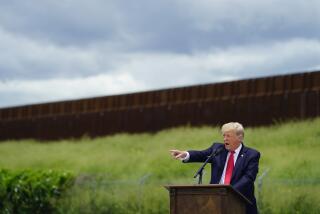Obama still might lose on immigration, no matter how the Supreme Court rules
Reporting from Washington — President Obama’s fight to bring millions of immigrants out of the shadows of American life now faces the scrutiny of the highest court in the land, but even if his effort is deemed legal this summer, he may run out of time to cement it into place.
All along, advocates have hoped that Obama’s executive actions to grant lawful presence and work permits to as many as 5 million people would take effect and become so popular that even a GOP president couldn’t undo them.
But a federal judge put the programs on hold last year in the middle of a legal fight over them, and even with the announcement Tuesday that the Supreme Court will hear the case, Obama’s actions remain on hold until at least this summer. Under the best-case scenario for the president, he would have only six months to implement the plan before he leaves office.
Join the conversation on Facebook >>
That may not be enough time to get millions of people into his programs in a way that weaves them so deeply into the fabric of American life that no future president would want to undo Obama’s actions.
And with every Republican presidential candidate opposed to his immigration policy, the fate of his plan depends heavily on the election of a Democratic successor.
The state of play reflects the perils of Obama’s choice to make dramatic policy changes by executive action rather than by working with Congress, and serves as a reminder of what he may anticipate if he continues to govern by unilateral authority.
Still, Obama likely faces even more opposition from Congress during his final year in office, leaving him with few other options for advancing his agenda and protecting his legacy.
It was his frustration with lawmakers that first inspired Obama to go around Congress. Under pressure from immigration advocates and impatient with Republicans in the House who’d derailed reform, Obama acted unilaterally to create the program in November 2014.
The program would provide temporary protection from deportation for up to 5 million immigrants living in the country illegally, including many parents of U.S. citizens. Administration lawyers said Obama had the legal authority to act without congressional approval; they describe the program as simply an extension of the executive branch’s power to order or stay deportations of individuals.
But the program was challenged by a coalition of 26 mostly Republican-led states. U.S. District Judge Andrew S. Hanen of Texas decided that Obama had overstepped his constitutional authority and had created a “total abdication and surrender” of the duty to enforce immigration laws.
The administration had to halt preparations for the program that had already begun; it had granted contracts to consulting firms and rented office space in Virginia to process the expected millions of applications. Likewise, nonprofit and advocacy groups that work with immigrants had to suspend their plans to coach people through the process of applying.
Assuming that the Supreme Court allows the program to proceed, it will be difficult to move applicants through the process quickly enough to reach all the eligible adults, said Randy Capps, director of research for the nonprofit Migration Policy Institute.

In the past, Capps said, many immigrants were slow to apply at first.
“It takes a little time to get the word out,” Capps said. “That means the big wave is not going to come in the first month or two when they roll it out. It’ll come in the fall, potentially right smack in the middle of the election.”
He said it will be hard to process more than a “couple hundred thousand” applicants before a new administration takes over.
“Who knows? Maybe they could get close to a million people to submit -- that seems to be heroic,” he said. “They would be sitting on huge queue of applications when the new administration takes office.”
White House Press Secretary Josh Earnest on Tuesday downplayed concerns about whether there will be enough time to set the president’s directives in motion.
The experience of implementing other immigrant policy suggests that a lot of people would rush to sign up, he said.
Eligible applicants “would take advantage of the benefits as soon as they possibly could,” Earnest predicted during his daily briefing with reporters.
Even just a few months of strong enrollment could preserve Obama’s goal. If the Supreme Court upholds his actions, the next president could take office with a large number of applications on his or her desk waiting for approval.
For a newly seated Republican president, that would present a dilemma. By making good on a promise to be tough on immigration, he or she would be deporting hundreds of thousands of longtime residents who voluntarily came forward to follow the rules -- a dramatic and memorable moment to begin the new presidency.
White House officials hastened to point out the possibility that the next president will not balk at making that call.
Latino voters are a crucial demographic in the race to succeed Obama. A strong turnout for Democrats on election day could be decisive.
Their votes could also sway congressional elections. The White House consistently points out that Obama has taken executive action only because the Republican-led Congress hasn’t done so.
“That’s why we’re going to continue to press Congress to take those steps,” Earnest said.
ALSO
Don’t think that the U.S. and Iran are done butting heads
What happened to El Niño? Be patient, L.A., it’ll come, expert says
This Texas barbecue joint will give you a discount for carrying a gun
More to Read
Sign up for Essential California
The most important California stories and recommendations in your inbox every morning.
You may occasionally receive promotional content from the Los Angeles Times.












